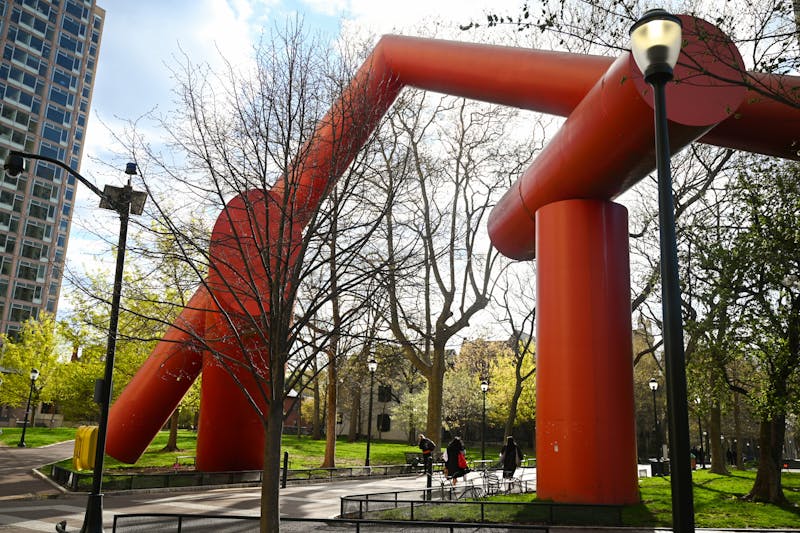
Penn witnessed record-high voter turnout on Election Day — and cast its ballots overwhelmingly for Vice President Kamala Harris and other Democratic candidates.
On Nov. 5, four primary polling locations across Penn’s campus — the ARCH building, Houston Hall, Walnut Street West Library, and Civic House — witnessed a dramatic 450% increase in in-person voter turnout compared to the 2020 election. Of votes cast in the presidential race across the four locations on Election Day, Harris received 81.6% of votes, while 16.3% voted for former President and 1968 Wharton graduate Donald Trump.
The proportion of votes for Harris is a slight decrease from the 83% of ballots that were cast for President Joe Biden on Election Day on Penn’s campus in 2020. Harris’ 81.6% also marks an even starker decrease from the 91% of votes cast for former Secretary of State and 2016 Democratic nominee Hillary Clinton.
In the highly contentious United States Senate race between incumbent Democrat Sen. Bob Casey (D-Pa.) and Republican Dave McCormick, the majority of Penn voters on Election Day went blue — but support for Casey lagged behind that for Harris. 79.8% of voters supported Casey, while McCormick received 17.7% of the votes and third-party candidates gained the support of only 2.5% of Penn voters.
A total of 5,132 ballots were cast across the University between 7 a.m. and 8 p.m. in this year’s election. In the presidential race, 79 ballots across the four locations were cast for a third-party candidate, while 30 voters wrote in candidates for the presidential race.
Among the four polling locations, Houston Hall saw the most voters, with 2,797 ballots being cast in Bodek Lounge over the course of Election Day. At the ARCH, voters cast 1,273 ballots, and the Walnut Street West Library and Civic House saw 719 and 343 ballots cast, respectively.
During the 2020 general election, The Daily Pennsylvanian reported that just over 1,000 ballots were cast across the ARCH, Houston Hall, and the Walnut Street West Library — meaning that this year’s election saw nearly 4,000 additional ballots cast, around an average increase of 450% in turnout on campus between presidential election cycles. However, voter turnout at Penn in 2020 was impacted by the COVID-19 pandemic, when students largely did not live on campus during the fall 2020 semester.
The 2024 general election voter totals feature more than double the in-person turnout of the 2022 midterm elections, which saw 2,239 votes cast across the ARCH, Houston Hall, and Civic House. The 2022 and 2024 elections both featured high-profile races for U.S. Senate seats, and on both occasions the Democratic candidate — now-Sen. John Fetterman (D-Pa.) in 2022 and Sen. Bob Casey (D-Pa.) in 2024 — won handily on Penn’s campus.
The marked increase in voter participation is part of an upward trend on Penn’s campus since at least 2016. Penn Leads the Vote, a nonpartisan student organization focused on civic engagement across campus, has reported a general increase in the rate of on-campus voting since 2012.
Democratic candidates in down-ballot elections at the state level all came out on top among Penn voters. Candidate for Pennsylvania attorney general Eugene DePasquale, who is a Democrat, earned 78.4% of the votes on campus. In the race for auditor general, 79.3% of ballots cast on campus were in support of state Rep. Malcolm Kenyatta (D-Philadelphia). Democrat Erin McClelland gained the support of 79.2% of Penn’s voters in her race for state treasurer.
Three candidates on the ballot — all incumbents — ran uncontested. Pennsylvania state Rep. Rick Krajewski (D-Philadelphia) and state Sen. Vincent Hughes (D-Philadelphia) will both serve another term. Rep. Dwight Evans (D-Pa.) will also retain his spot in Congress for another two years.
The Daily Pennsylvanian is an independent, student-run newspaper. Please consider making a donation to support the coverage that shapes the University. Your generosity ensures a future of strong journalism at Penn.
Donate







